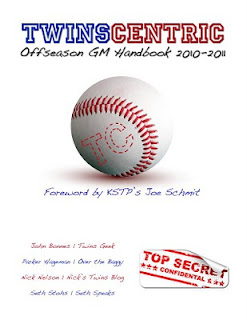The seasons for all of the Twins' minor-league affiliates have drawn a close, so this seems an appropriate time to take a final look at how the players I ranked as my
top ten prospects in the organization fared here in 2011.
Much like with the big-league club, you'll find that this list is riddled with setbacks and major injuries. It seems no one in the organization can escape the voodoo hex that has befallen the Twins.
10. Carlos Gutierrez, RP
2011 Stats (AAA): 62.1 IP, 4.62 ERA, 57/31 K/BB, 1.46 WHIP
One thing is clear: the Twins have settled on Gutierrez's role. After making almost half of his appearances last year as a starter, the righty pitched exclusively in relief for the Red Wings. His strikeout rate of 8.2 K/9 was by far the highest of his career -- a promising sign for the sinker baller -- but his results were truly ugly after returning from an arm injury that cost him all of July, as he allowed 11 runs on 18 hits and six walks over 13 2/3 innings between August and September.
Having seen Gutierrez pitch live a few times, I'm definitely a believer in his talent and expect him to be an impact arm in the Twins' bullpen in the coming years.
9. Liam Hendriks, SP
2011 Stats (AA/AAA): 139.1 IP, 3.36 ERA, 111/21 K/BB, 1.13 WHIP
Hendriks sneaked onto this list with a spectacular 2010 campaign and then backed it up here in 2011, assuring that he'll rise several slots next year. The Australian right-hander demolished Double-A, posting a 2.70 ERA and 81/18 K/BB ratio in 90 innings, before holding his own in Rochester and earning a September call-up to the big leagues.
Despite his dazzling numbers in Single-A and Double-A, the 22-year-old profiles as a back-of-the-rotation starter in the majors, falling into the Twins' mold as a prolific strike-thrower with marginal stuff. With that being said, he's clearly established himself as the organization's top MLB-ready pitching prospect.
8. Angel Morales, OF
2011 Stats (A+): .264/.326/.388, 3 HR, 13 RBI, 17 R, 3/5 SB
Morales hurt his right elbow while playing ball in Puerto Rico last winter, and the injury kept him off the field for much of the 2011 campaign. At one point, it seemed likely that the outfielder would be forced to undergo Tommy John surgery, but doctors elected instead for a minor surgery in June to remove bone chips.
He returned to the Miracle in late July and played in 33 games, posting the numbers you see above over 138 plate appearances. His strikeout rate rose to a career-high 26 percent, raising concern over what may be a crippling deficiency in his offensive game. All in all, this sadly looks like a lost year for Morales, who will probably open in Fort Myers once again in 2012.
The Twins need to add Morales to the 40-man roster this offseason in order to protect him from the Rule V draft. It will be interesting to see if they choose to take that step.
7. Alex Wimmers, SP
2011 Stats (A+): 40.2 IP, 4.20 ERA, 39/22 K/BB, 1.23 WHIP
The Twins' first-round draft pick a year ago, Wimmers started his season on a depressing low note, walking all six batters he faced in his first start for the Miracle after dominating in a short stint at the same level a year ago. Twins fans groaned as they recalled the case of Shooter Hunt, who burst onto the scene after being drafted before completely losing the ability to throw strikes.
However, to his credit, Wimmers went to extended spring training, worked with his coaches and got back on track, returning to the Miracle in July and posting much better numbers the rest of the way while splitting time between the bullpen and rotation. In July, August and September, the 22-year-old righty posted a 3.32 ERA and 39/16 K/BB ratio over 40 2/3 innings. He still struggled with walks from time to time so he's not out of the woods yet, but Wimmers is poised for a big season in 2012 if he can keep the control demons at bay.
6. David Bromberg, SP
2011 Stats (AA): 37 IP, 6.08 ERA, 23/15 K/BB, 1.75 WHIP
After a solid stint in Rochester to close out his 2010 campaign, Bromberg seemed ready to step up to the majors if the Twins needed help this season. Instead, he opened the season back in New Britain and was hit by a comebacker in early May that fractured his arm. He'd miss significant time and make only four more starts for the Rock Cats, turning in a 9.82 ERA and 12-to-11 strikeout-to-walk ratio over 14 2/3 innings while allowing a .406 batting average.
Bromberg, who turns 24 in a week, will enter next season with much to prove after a ruined 2011.
5. Joe Benson, OF
2011 Stats (AA): 285/.388/.495, 16 HR, 67 RBI, 69 R, 13/22 SB
Benson's season stands out as one of the true bright spots on this list. Although he spent most of his time at Double-A for a second consecutive year and continued to strike out at an alarming rate (109 times in 472 plate appearances), he raised his batting average by 30 points and his on-base percentage by 50. A year after blasting 27 homers between Fort Myers and New Britain, Benson went deep 16 times for the Rock Cats, including 11 in the second half.
He's very athletic and will almost certainly be a defensive asset, but Benson still has strides to make at the plate in order to become a true threat in the lineup.
4. Ben Revere, OF
2011 Stats (AAA): .303/.338/.364, 1 HR, 9 RBI, 15 R, 8/10 SB
After posting the pedestrian numbers shown above in 32 games for Rochester, Revere was called up to the Twins for good in mid-June and -- despite leaving much to be desired with his offensive performance -- he's been a mainstay in the lineup ever since. His game-changing speed and eye-popping defense seem to have ingratiated him with the coaching staff, putting him in position to claim a spot in next year's outfield.
He's been a drain this year with his .583 OPS, but if Revere can hit .300 he'll be a serviceable offensive player and a worthwhile starter. He hasn't shown that ability yet in Minnesota, but he's done it at every level of the minors. Plus. he has accumulated a lot of valuable major-league experience this year, and he's the same age as Benson and Chris Parmelee, who are just now getting their first taste.
3. Miguel Sano, 3B
2011 Stats (Adv Rk): .292/.352/.637, 20 HR, 59 RBI, 58 R, 5/9 SB
Sano posted those numbers in just 66 games. Projected to 162, that would work out to 49 home runs and 145 RBI. Granted, it's just rookie ball, but Sano is only 18 years old. He has his flaws, most notably in his plate discipline, but he appears to be the best power bat that has come through this organization in some time. Of course, he's still got a long way to go.
2. Aaron Hicks, OF
2011 Stats (A+): .242/.354/.368, 5 HR, 38 RBI, 79 R, 17/25 SB
He's a world class athlete, but so far on the field Hicks has only proven to be an enigma. While his ability to draw walks remains exciting (his 14.7 percent walk rate in Fort Myers this year would have led the Twins), his power still hasn't developed and he didn't exactly rake like you'd hope a 21-year-old top prospect in Single-A would. Hicks remains on track to reach Target Field in a few years, but his star is dimming with each unspectacular minor-league campaign.
1. Kyle Gibson, SP
2011 Stats (AAA): 95.1 IP, 4.81 ERA, 91/27 K/BB, 1.43 WHIP
After dazzling Twins coaches during spring training, Gibson picked up where he left off in 2010, performing well out of the gates for Rochester. As the season progressed, though, Gibson increasingly had difficulty lasting deep into games. He was shut down due to elbow soreness in late July, diagnosed with a torn ligament in early August, and placed under the knife for Tommy John surgery earlier this week.
Gibson, who at one point was almost certainly being figured into the Twins' 2012 rotation, will now miss the entire season. He'll hope to return in 2013 while facing fewer tribulations than recent local hurlers who have undergone the procedure.
Tough break for the kid. And for the Twins.



